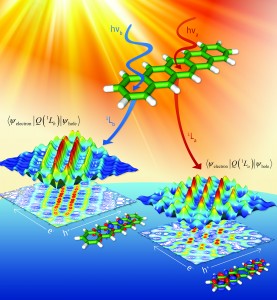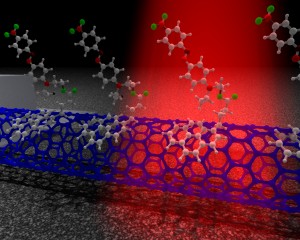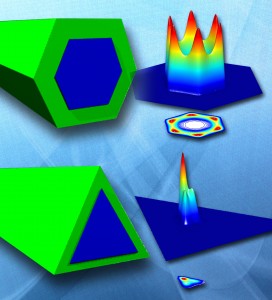Our research in computational chemistry and materials science seeks a deeper understanding of electron dynamics for energy generation and conversion in nanoscale and mesoscale materials. The theoretical and computational tools developed in our laboratory have immense predictive power, and several of our calculations are used by experimentalists to rationally design new promising materials. Our research missions are to predict, understand, and control the fundamental electronic interactions in various energy material systems, given in detail below.
 Electronic Properties of Light-Harvesting Systems. Our ability to tune the electronic properties in light-harvesting systems at the molecular level is critical for designing next-generation materials and devices. We use computational methods to predict the efficiencies of these candidate materials in order to guide future experimental efforts. In particular, density functional theory (DFT) and time-dependent density functional theory (TD-DFT) allow us to make detailed predictions on the optoelectronic properties of light-harvesting systems. However, the complex many-body effects in these materials pose a significant problem for standard DFT methods. Our research in range-separated DFT and real-time TD-DFT methods provides a fast and predictive path for understanding and controlling optoelectronic properties due to their improved accuracy, computational efficiency, and theoretical rigorousness.
Electronic Properties of Light-Harvesting Systems. Our ability to tune the electronic properties in light-harvesting systems at the molecular level is critical for designing next-generation materials and devices. We use computational methods to predict the efficiencies of these candidate materials in order to guide future experimental efforts. In particular, density functional theory (DFT) and time-dependent density functional theory (TD-DFT) allow us to make detailed predictions on the optoelectronic properties of light-harvesting systems. However, the complex many-body effects in these materials pose a significant problem for standard DFT methods. Our research in range-separated DFT and real-time TD-DFT methods provides a fast and predictive path for understanding and controlling optoelectronic properties due to their improved accuracy, computational efficiency, and theoretical rigorousness.
For more information on this topic, further details of our work can be found in the following papers:
B. M. Wong and J. G. Cordaro, “Coumarin Dyes for Dye-Sensitized Solar Cells: A Long-Range-Corrected Density Functional Study.” Journal of Chemical Physics, 129, 214703 (2008). [pdf]
B. M. Wong, M. Piacenza, and F. Della Sala, “Absorption and Fluorescence Properties of Oligothiophene Biomarkers from Long-Range-Corrected Time-Dependent Density Functional Theory.” Physical Chemistry Chemical Physics, 11, 4498 (2009). [pdf]
B. M. Wong, “Optoelectronic Properties of Carbon Nanorings: Excitonic Effects from Time-Dependent Density Functional Theory.” Journal of Physical Chemistry C, 113, 21921 (2009). [pdf]
B. M. Wong, and T. H. Hsieh, “Optoelectronic and Excitonic Properties of Oligoacenes: Substantial Improvements from Range-Separated Time-Dependent Density Functional Theory.” Journal of Chemical Theory and Computation, 6, 3704 (2010). [pdf]
B. M. Wong and J. W. Lee, “Anomalous Optoelectronic Properties of Chiral Carbon Nanorings…and One Ring to Rule Them All.” Journal of Physical Chemistry Letters, 2, 2702 (2011). [pdf]
M. E. Foster and B. M. Wong, “Non-Empirically Tuned Range-Separated DFT Accurately Predicts Both Fundamental and Excitation Gaps in DNA and RNA Nucleobases.” Journal of Chemical Theory and Computation, 8, 2682 (2012). [pdf]
 Light-Induced Conductance in Carbon Nanomaterials. Phototransduction plays a central role in natural processes such as human vision and photosynthesis. While researchers have long tried to mimic these processes in bulk materials, several factors limit their performance. An alternative to these conventional approaches is the integration of light-sensitive molecules with nanomaterials, tailored specifically to respond to environmental stimuli. Our experimental colleagues at the University of Wisconsin-Madison in collaboration with our group recently showed that a chromophore-functionalized carbon nanotube can be used as an optically-activated field-effect transistor. New, predictive methods developed in our group provide deep insight into the photo-induced mechanisms that control energy conversion efficiency in these complex nanoscale materials.
Light-Induced Conductance in Carbon Nanomaterials. Phototransduction plays a central role in natural processes such as human vision and photosynthesis. While researchers have long tried to mimic these processes in bulk materials, several factors limit their performance. An alternative to these conventional approaches is the integration of light-sensitive molecules with nanomaterials, tailored specifically to respond to environmental stimuli. Our experimental colleagues at the University of Wisconsin-Madison in collaboration with our group recently showed that a chromophore-functionalized carbon nanotube can be used as an optically-activated field-effect transistor. New, predictive methods developed in our group provide deep insight into the photo-induced mechanisms that control energy conversion efficiency in these complex nanoscale materials.
For more information on this topic, further details of our work can be found in the following papers:
X. Zhou, T. Zifer, B. M. Wong, K. L. Krafcik, F. Léonard, and A. L. Vance, “Color Detection Using Chromophore-Nanotube Hybrid Devices.” Nano Letters, 9, 1028 (2009). [pdf]
C. Huang, R. K. Wang, B. M. Wong, D. J. McGee, F. Léonard, Y. J. Kim, K. F. Johnson, M. S. Arnold, M. A. Eriksson, and P. Gopalan, “Spectroscopic Properties of Nanotube-Chromophore Hybrids.” ACS Nano, 5, 7767 (2011). [pdf]
Y. Zhao, C. Huang, M. Kim, B. M. Wong, F. Léonard, P. Gopalan, and M. A. Eriksson, “Functionalization of Single-Wall Carbon Nanotubes with Chromophores of Opposite Internal Dipole Orientation.” ACS Applied Materials & Interfaces, 5, 9355 (2013). [pdf]
C. Huang, M. Kim, B. M. Wong, N. S. Safron, M. S. Arnold, and P. Gopalan, “Raman Enhancement of a Dipolar Molecule on Graphene.” Journal of Physical Chemistry C, 118, 2077 (2014). [pdf]
 Charge and Energy Transport in Mesoscale Materials. Lighting consumes 22% of U.S. electricity, at a 50 billion per year cost to the U.S. consumer. Of all areas of energy science and technology, solid-state lighting is among the best suited for conveying to the public the importance of energy research, and the long-term benefit of energy science to current technologies. Although bulk materials are still used in solid-state lighting systems, 1D nanowires demonstrate enhanced energy-conversion efficiencies due to their reduced dimensionality and proximity to surfaces and interfaces. Most importantly, because of how charge carriers are confined in these 1D geometries, they present unique challenges to both experiment and theory for controlling energy transport in these mesoscale materials.
Charge and Energy Transport in Mesoscale Materials. Lighting consumes 22% of U.S. electricity, at a 50 billion per year cost to the U.S. consumer. Of all areas of energy science and technology, solid-state lighting is among the best suited for conveying to the public the importance of energy research, and the long-term benefit of energy science to current technologies. Although bulk materials are still used in solid-state lighting systems, 1D nanowires demonstrate enhanced energy-conversion efficiencies due to their reduced dimensionality and proximity to surfaces and interfaces. Most importantly, because of how charge carriers are confined in these 1D geometries, they present unique challenges to both experiment and theory for controlling energy transport in these mesoscale materials.
For more information on this topic, further details of our work can be found in the following papers:
B. M. Wong, F. Léonard, Q. Li, and G. T. Wang, “Nanoscale Effects on Heterojunction Electron Gases in GaN/AlGaN Core/Shell Nanowires.” Nano Letters, 11, 3074 (2011). [pdf]
A. W. Long and B. M. Wong, “PAMELA: An Open-Source Software Package for Calculating Nonlocal Exact Exchange Effects on Electron Gases in Core-Shell Nanowires.” AIP Advances, 2, 032173 (2012). [pdf]
M. Fickenscher, T. Shi, H. E. Jackson, L. M. Smith, J. M. Yarrison-Rice, C. Zheng, P. Miller, J. Etheridge, B. M. Wong, Q. Gao, S. Deshpande, H. H. Tan, and C. Jagadish, “Optical, Structural, and Numerical Investigations of GaAs/AlGaAs Core–Multishell Nanowire Quantum Well Tubes.” Nano Letters, 13, 1016 (2013). [pdf]
K. Pemasiri, H. E. Jackson, L. M. Smith, B. M. Wong, S. Paiman, Q. Gao, H. H. Tan, and C. Jagadish, “Quantum Confinement of Excitons in Wurtzite InP Nanowires.” Journal of Applied Physics, 117, 194306 (2015). [pdf]